Eight
Wedding Behavior and Family Strategies in Chengdu
Martin King Whyte
Marriage decisions are central to any discussion of family strategies. Normally, marriage is a central step in the age-old Chinese effort to continue the family line.[1] It should also be obvious that not just any marriage will do. Which individuals sons or daughters marry may have important consequences for the future prospects not only of those sons and daughters, but also of the larger families in which they grew up. Which partners are chosen and how the wedding is celebrated may affect the social status and links to useful patrons and allies of those involved. And whether particular marriages result in an expansion of an existing family (by the couple's moving in with what I call an "old family") or the setting up of an independent household (which I call, for the sake of simplicity, a "new family") may influence the opportunities Chinese have to succeed in the world that confronts them. For these and other reasons it is obvious that marriage is a central focus of family strategic thinking. In this chapter I analyze survey data from one Chinese city in an effort to gain insight into how family strategic behavior in regard to getting married may have changed over time, and particularly in the post-Mao or reform period (i.e., since 1978).
With colleagues at Sichuan University I collected survey data in Chengdu, the capital of Sichuan province, in 1987.[2] Our interviewees were a probability sample of 586 ever-married women between the ages of twenty
[1] Concubinage, adoption, and other steps may be taken to this end, but for most Chinese, and particularly since 1949, marriage has been an essential prerequisite to family continuity.
[2] My Chinese collaborators are Yuan Yayu and Xu Xiaohe, both affiliated with the Sociology Research Office of Sichuan University. Our research was supported by the U.S.-China Cooperative Science Program of the National Science Foundation and also by the United Board for Christian Higher Education in Asia, Sichuan University, and China's State Education Commission.
and seventy who lived in the two main urban districts of that city. Since we asked our respondents a variety of questions about how they first got married, and since the dates of those first marriages ranged over the fiftyfive years from 1933 to 1987, we are able to say quite a bit about how the marriage experiences of these women have varied across time periods.[3] Given a particular interest in the reform period, we can examine whether women in Chengdu who married after 1978 did things differently than women who married in earlier periods.
Here I intend to go beyond simply examining whether wedding behavior has changed over time in Chengdu. A number of more complex questions are of interest and may tell us something about shifts in family strategies. For example, how did social groups within Chengdu differ in their wedding behavior? Which types of individuals or families were most likely to have experienced arranged marriages, to have had elaborate weddings, or to have set up new households after marrying? Have the "social correlates" of different kinds of wedding behavior changed over time, and particularly in the post-1978 period? Is there any sign in our data, for instance, of a group of nouveaux riches families arising as a result of the reforms and distinguishing themselves by holding particularly elaborate weddings? Did families of Party members "hold the line" against the revival of elaborate weddings in the reform period, or did such families lead the way in this trend? These are ad hoc examples of the kinds of questions we can address with our Chengdu data. Since much evidence on how wedding behavior has changed over time has already been presented,[4] after reviewing that evidence briefly here, my main focus will be on the social sources of variation in wedding behavior in Chengdu and how those sources may have changed over time.
I should clarify at the outset that, although like my fellow authors I am interested in family strategies, the evidence I have to work with—the
[3] The response rate for the survey was 87.7%. Chengdu is, of course, not "typical" of all of urban China, but it is not especially unusual in comparison with other major cities in China. (Chengdu is China's tenth largest city, with an estimated population of 2.6 million in 1985.) Inferring change over time from this kind of cross-sectional sample is, of course, not an easy matter. Many of the older women in our sample were not living in Chengdu at the time they first married, and many of the women who were getting married in that city in the 1930s and 1940s have either died or moved elsewhere. So the data presented here cannot, properly speaking, tell us how the wedding behavior of representative members of the Chengdu population varied across time periods. Instead, they should be interpreted as telling us how the wedding experiences of a representative sample of women living in Chengdu in 1987 differed depending upon the time at which they married.
[4] See Martin King Whyte, "Changes in Mate Choice in Chengdu," in Chinese Society on the Eve of Tiananmen , ed. Deborah Davis and Ezra Vogel, 181-213 (Cambridge: Harvard University Press, 1990).
Chengdu survey data—does not contain any direct information about such strategies. We asked respondents questions about such things as who made the decision about whom to marry, how much was spent on the wedding, who paid for the celebration, and where the couple lived after the wedding. We did not, however, ask any questions about why things had been done in a certain way or about how the decisions were arrived at and with what family goals and concerns in mind. To address questions such as these properly would require a different research technique, involving intensive, in-depth interviews rather than a roughly one-hour-questionnaire survey. Even if we had used this alternative technique we would have faced difficulties, since the older respondents in our sample might have difficulty remembering and providing accurate reconstructions of family strategic thinking three or more decades earlier, and many of them (particularly those who experienced strictly arranged marriages) were not consulted at the time.
In the absence of direct information about family strategic thinking, I am forced to rely on inference here. My approach is to look for overall patterns in the data to see what those patterns might indicate about family strategies and changes in such strategies. I contend that if family strategies have been operating with any degree of success, we should see evidence of the operation of such strategies in our data on wedding behavior. If we do not find such interpretable patterns in our data, then we have evidence either that family strategies were not successful or that they did not exist in a coherent way in the first place. Inferring family strategies from such patterns in the data is not an easy or exact process.
Changes in Mate Choice in Chengdu
How did wedding behavior change over time in Chengdu, and what do any trends tell us about changing families and family strategies in that city? In dealing with these questions, I focus on aspects of wedding behavior that tell something about changes in intergenerational relations.[5] This focus is important because it may help us deal with a central question in the study of family strategies: What is the proper unit of analysis? To put the question in a different way, when we want to study the formulation and negotiation of strategies for success in urban China, does it make most sense to look at individuals, at what I call new families, or perhaps at old families? Who, after all, is involved in these kinds of decisions? And might it not be that the locus of strategic thinking in regard to marriage has changed in
[5] A more general examination of changes in a broad range of mate choice and wedding customs has already been published. See Whyte, "Changes in Mate Choice in Chengdu."
fundamental ways over time, from parents and family elders (the leaders of old families) to potential brides and grooms (those who will form the new families)? By examining what wedding behavior tells about shifts in relative power, social ties, and interdependency between generations, we may be able to draw inferences about basic changes in the nature and locus of family strategic thinking in contemporary China.
There are good reasons for assuming in advance that basic changes in the nature of intergenerational relations may have occurred in twentieth-century China. All that we know about the nature of marriage in late imperial China suggests that for most this was a relatively extreme form of arranged marriage in which the old family was the locus of power and the new family had little if any voice. Parents or other senior kin decided when it was time for children to marry and whom they should marry, and in many cases the young couple was not consulted and did not even meet until the day of the wedding. Sometimes a child betrothal or adoption of a future daughter-in-law as an infant was involved, making even clearer the total subordination of the younger generation to the wishes of their elders. Negotiations over brideprices and dowries and the financing of a wedding feast were also matters of family decision, rather than issues left for the young couple. Usually there was an expectation that the new family would be incorporated into the old through patrilocal residence, but even if not, the decision about where to live and how to earn a living were often matters determined more by the old family than the new. In some accounts from earlier times we learn of families making decisions to have one son study for the imperial examinations, another remain in the household and take over the family farm, and another go off to work in a market town or city, all in an effort to maximize chances for family success.[6] The power of the older generation and the role of that generation in making decisions about family strategy were reinforced and expressed in multiple ways in marriage behavior in late imperial China.
Changes that weakened the power of the old family in marriage matters were already under way before the Chinese Communist Party (CCP) came to national power in 1949. Both growing industrialization and commercialization and the spread of Western ideas about marriage and family life fostered trends toward greater independence of the young in the first half of
[6] This scenario is somewhat idealized and would have applied mostly to families already well above the margin of subsistence. But in general a picture of the old family fairly explicitly dictating the lives of the young is a commonplace in descriptions of social life and social mobility in earlier times. See, for example, Ho Ping-ti, The Ladder of Success in Imperial China (New York: Science Editions, 1964); Yung-teh Chow, Social Mobility in China (New York: Atherton Press, 1966); Lin Yueh-hwa, The Golden Wing (London: Kegan Paul, 1947). The best-known fictional portrayal of the conflict over the power of the elders to control the fate of young family members is Pa Chin, Family (Garden City: Anchor Books, 1972 [originally 1933]).
the twentieth century.[7] After 1949 the CCP used its impressive power to campaign against arranged marriage and other manifestations of parental power. Both economic development and the socialist transformation of property relations carried out by the CCP should have weakened further the power and resources parents could wield in their efforts to dictate marriage matters.[8] Further economic development and the return of Western cultural influence during the reform period could be expected to accentuate these trends even more. How does the evidence from Chengdu fit these expectations?
The first aspect of marriage behavior to consider is the degree of freedom of mate choice—whether parents (or other family elders) or the young couple play the dominant role in deciding whom to marry. In this realm there have been clear changes, as the data presented in table 8.1 reveal. (This table and table 8.2 divide years of first marriage into periods that correspond roughly to important turning points in the history of contemporary China.) In general, there has been a shift from the old family to the new family in terms of who makes the selection of marital partners. (Other trends shown in the table have already been discussed in previous writings and will not be focused on here.) A more fine-grained analysis, making use of a summary scale and finer time divisions, reveals a somewhat more complex pattern. In figure 8.1 I display a three-year moving average of a summary Freedom of Mate Choice Scale across years of marriage.[9]
Figure 8.1 confirms that the change toward increasing freedom of mate choice was already under way prior to 1949 and that this trend continued during the 1950s. However, the figure also reveals that after about 1957 this shift more or less "stalled," with little net change toward greater freedom of mate choice during subsequent periods. Neither the storms of the Cultural Revolution nor the frenetic changes of the reform period had much effect on the freedom of young people in Chengdu to choose their own mates. To summarize briefly, I argue that the 1950s involved a massive structural change—the socialist transformation of the urban economy. That change
[7] These trends are documented in Olga Lang, Chinese Family and Society (New Haven: Yale University Press, 1946). See also Marion Levy, The Family Revolution in Modern China (Cambridge: Harvard University Press, 1949).
[8] The classic work on how various aspects of "modernization" produce changes that give young couples more autonomy is William J. Goode, World Revolution and Family Patterns (New York: Free Press, 1963).
[9] The summary Freedom of Mate Choice Scale was constructed from the mean of the standardized scores of each respondent on six questions—those numbered 1, 2, 3, 6, 7, and 9 in table 8.1. A three-year moving average is constructed by taking the average of the scores for the years before and after a particular year. For example, the value for 1957 is an average of the values for 1956, 1957, and 1958. This procedure is followed to compensate for modest numbers of cases in each marriage year, and the result is a smoother and more readily interpretable graph.
| ||||||||||||||||||||||||||||||||||||||||||||||||||||||||||||||||||||||||||||||||||||||||||||||||||||||||||||||||||||||||||||||||||||||||||||||||||||||||||||||||||||||||||||||||||||||||||||||||||||||||||||||||||||||||||||||||||||||||||||||
| ||||||||||||||||||||||||||||||||||||||||||||||||||||||||||||||||||||||||||||||||||||||||||||||||||||||||||||||||||||||||||||||||||||||||||||||||||||||||||||||||||||||||
reduced the power of parents dramatically, since they no longer controlled property or access to adult jobs, but urban young people gained increased autonomy only up to a point. The real winner was the bureaucratic system constructed by the CCP, which controlled education, employment, health care, housing, and all other important resources. Young people found that some of the freedom gained from parents was lost to the bureaucratic gatekeepers of the state (in schools, factories, etc.), individuals who were decidedly not indifferent to when and how young people married.[10]
[10] This central role of the bureaucratic state is the decisive element left out of Goode's account of modernization and family change in capitalist countries. In the capitalist world, both governments and employers and other bureaucratic gatekeepers are largely indifferent to the private lives of the young, so that power lost by parents is gained by the young.

Fig. 8.1.
Freedom of Mate Choice, Moving Average
A variety of measures of wedding celebrations and wedding finances are displayed in table 8.2. Also included in that table are responses to a question about where the couple lived after the wedding. There are dramatic changes across time visible in these figures, but the pattern is quite different from the one seen in table 8.1 and figure 8.1. Broadly speaking, what we see here is a curvilinear trend. Initially there are sharp shifts away from "traditional" patterns. By the late 1950s and 1960s fewer couples were having wedding ceremonies and banquets, fewer people were being invited to such events when they were held, marriage finance transactions (e.g., brideprices, dowries) were less common, less money was being spent, more often the bride and groom were paying for any festivities themselves, and it was increasingly common for the new family to reside separately from either his or her parents.[11] In more recent times, however, all of these trends have been reversed. By the final period, the era of the reforms, wedding ceremonies, and banquets are once again increasingly common, more people are being invited to them, more is being spent on them, and it is less and less common for the young couple to finance their weddings themselves. By the same token, postmarital residence in a new household has become less common during the reform period, with moving in with the groom's or the bride's parents (most commonly still the former) once again on the rise (see also the figures presented in chapter 2 by Unger).[12] So in these realms we see not a stalling of a pattern of change, but an apparent reversal and return toward more "traditional" patterns.[13]
[11] A variety of other aspects of change in wedding customs are not displayed in table 8.2. In general many couples who married between the 1950s and 1970s in urban China followed the models espoused by the CCP by holding a simple celebration with close friends and workmates in the work unit, with tea and candy distributed to participants. In a few cases these "revolutionary" weddings included explicit political statements, such as a speech by the Party secretary encouraging devotion to the revolution, presentation of a set of Mao's writings to the couple, or having the couple bow to a bust or portrait of Mao Zedong. The role of the family is obviously strikingly deemphasized in such wedding ceremonies, which contrast very clearly with the traditional wedding, in which the family-run feast is the central event. The spartan nature of these "revolutionary weddings" helps explain why so much less was spent and why couples could finance things themselves. It might be noted that we asked a question about another officially espoused model, the "collective wedding," in which large numbers of couples are married at a single time in a public ceremony presided over by CCP officials. We found very few cases in our sample of such collective weddings in any time period.
[12] Richard Barrett (personal communication) has found evidence from the 1985 In Depth Fertility Surveys that shows a similar trend of neolocal residence declining and patrilocal residence increasing during the 1980s in urban areas of several provinces (Beijing, Shandong, Liaoning, and Guangdong).
[13] There are a number of "new" elements also visible in Chengdu wedding customs in the 1980s. For example, wedding banquets in restaurants are increasingly common, something that fits the Hong Kong more than the traditional Chinese model. Similarly, the wearing of a Western-style white wedding gown for a formal wedding picture is increasingly the norm, and more and more couples are taking honeymoon trips. My claim is not that all aspects of wedding customs are reverting to traditional forms, but that those aspects of wedding celebrations that have implications for intergenerational relations are moving in that direction.
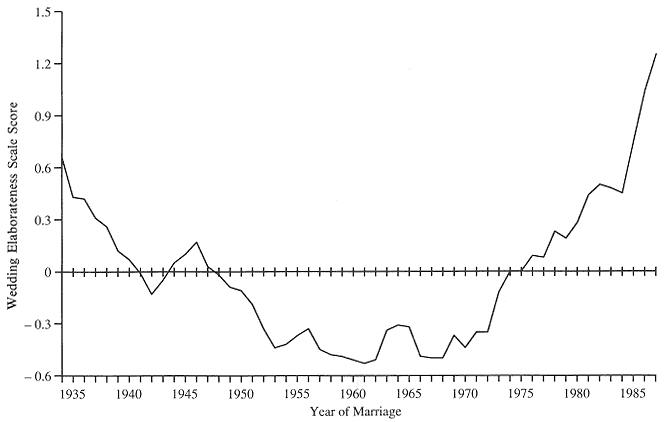
Fig. 8.2.
Wedding Elaborateness, Moving Average
As earlier in regard to freedom of mate choice, we can examine whether a more fine-grained analysis will reveal further details about these trends in wedding elaborateness and expenditures. I constructed a mean scale of wedding elaborateness from a variety of the available measures, and in figure 8.2 I graph a moving average of scores on that scale against years of marriage.[14] Figure 8.2 reinforces the conclusions already reached about a curvilinear time trend, but adds a few extra details. According to this measure, the elaborateness or costliness of weddings in the reform period appears to be even greater than in the prerevolutionary period. Also, the decline in wedding expenditures is visible even before 1949, whereas the revival of wedding costs begins prior to Mao's death, rather than after 1978.
Put very simply, I think a variety of forces are at work in these reversals of wedding behavior. In part we see reflected here a return to something closer to normalcy after the Cultural Revolution, as lessened CCP monitoring of private life made it possible for families once again to follow cherished practices in celebrating weddings. Also at work, at least after 1978, is the new official encouragement of conspicuous consumption and the rapidly increasing incomes of urbanites, factors that made possible and respectable the sorts of lavish weddings that would have gotten people into trouble only a few years previously. (On this score the CCP continued to advocate spartan wedding celebrations while saying it was good to get rich and that envy provided a powerful incentive for economic improvement. Encouraging restaurants, photography shops, and other service facilities to cater to popular needs and make profits also helped to fuel the revived "wedding trade.")
Even though the post-1978 improvements in consumption standards applied to housing as well as to food, clothing, and other areas, the increases in urban housing space were not translated into improved chances for young couples to get a place of their own. My interpretation of this apparently contradictory finding, admittedly speculative, is that in the context of housing demands suppressed for so long, with many older people with stalwart work and political records waiting on housing lists for years, newly marrying couples had less chance than in previous periods of getting allocated housing on their own. By continuing to live with either her parents or his they might be able to move into new housing as it became
[14] Included in the scale were seven items: those numbered 1, 2, 3, 4, 7, and 8 from table 8.2 and responses to a question about the monetary value of the dowry items (with zero used in cases with no wedding, banquet, or dowry). As with the Freedom of Mate Choice Scale earlier, this scale was formed by taking an average of standardized scores of each respondent on these seven items. This scale can be interpreted as measuring the elaborateness and costliness of the proceedings. Note that the postmarital residence measure is not part of this scale.
available during the 1980s.[15] (See the related discussion in the chapters by Davis, Unger, and Ikels.) In any case, in these realms we see a fairly consistent pattern that constitutes a reversal of the patterns that occurred in earlier years.
How are we to interpret the evidence presented so far? What do the data reviewed here tell us about shifting patterns in the relationship between generations in Chengdu families? What we do not see in this evidence is a pattern of "creeping individualism," of continuing growth in youth autonomy. Nor is the expectation of a linear trend toward more "modern" weddings borne out. Young people seem to have gained some power relative to their elders, at least when it comes to deciding whom to marry. However, their ability to live separately and rely on their own resources has actually diminished in recent years. We do not know, unfortunately, how in recent marriages it was decided how much to spend, how many to invite to the wedding, or where the couple would live afterward. But we can see that, even though the dominant role in choosing whom to marry is now in most cases played by "new families," in order to actually complete the process they have to rely on their "old families" in multiple ways. This continued and, indeed, revived intergenerational dependency may not mean that family elders are once again dictating matters to the young, but it would seem to require some sort of negotiation between generations over the nuts and bolts of how the wedding will be conducted and where the young couple will start out married life (a point also made by Davis in chapter 3). These results, taken as a whole, qualify my earlier discussion. This is not a situation in which powerless old families look on helplessly as the lives of their children are determined by an omnipotent and inflexible bureaucracy. Instead, continued family involvement and support appear to be vital to survival in the bureaucratic environment that is urban China. The trend toward increased youth autonomy from earlier in this century has been halted and in some respects even reversed.
Social Background and Wedding Behavior
Now I turn to the questions of how subgroups within the Chengdu population differed in their wedding behavior and whether the sources of variation in such behavior changed across time periods. In the pages that follow I review a wide range of evidence bearing on these questions by examining the correlations between various background traits of our respondents (and
[15] Figuring out how the housing supply affects patterns of postmarital residence is tricky. Young couples might end up with a place of their own for quite contradictory reasons—either because housing is so short that there is no space for them to move in with either set of parents or because housing in the city is so ample that young people can obtain their own place.
their old families) and their actual wedding experiences in various time periods.[16] From the large number of measures available from the Chengdu survey, I selected a limited range of important measures to examine, and consider only five basic aspects of wedding behavior: the degree of freedom of mate choice, the elaborateness of the wedding, whether or not there was a dowry presented by the bride's parents,[17] how much of the total wedding expenditures were borne by the young couple themselves, and whether the couple set up a new residence after the wedding. In terms of social background characteristics, I use a select subset of the available measures of three types: background characteristics of the individual bride and groom, background characteristics of their "old families," and "other" characteristics (i.e., traits that are not social status traits either of the bride and groom or of their families—for example, the year of the wedding, the age of the bride at the time, etc.).
Displayed separately here, the correlations between background characteristics and wedding behavior in three broad time periods—1933-57, 1958-77, and 1978-87, are collapsed further from the five categories used in previous tables. Each of these time periods has enough women in it (178, 198, and 210, respectively) to make analysis of correlations possible, but the main reason for these divisions is substantive. The first period involves the prerevolutionary era as well as the years after the CCP came to power but before the new socialist system was fully consolidated. The middle time period might be regarded as the years of full socialism or even "high Maoism"—they begin with the year in which Mao Zedong's visionary Great Leap Forward was launched and include the Cultural Revolution and its aftermath. The final time period is, of course, the era of the reforms initiated under the leadership of Deng Xiaoping.
What can we expect to learn by comparing correlations between social background traits and wedding behavior across these time periods? Of
[16] The correlation is not the most appropriate statistic to use in examining many of these relationships, since most of our variables are ordinal or even nominal, rather than interval. However, most nominal variables can be rearranged to make them ordinal (for example, with occupations ranging from low status to high), and the use of interval statistics, such as the Pearson product-moment correlation, to summarize findings is claimed by most experts to be an acceptable shorthand that in most cases leads to similar conclusions as relying on cross-tabulations and ordinal statistics. (A large number of cross-tabulations were examined as a preliminary to preparing table 8.3, and that examination confirmed this impression.) Also, full tables on so many variables would be completely unwieldy.
[17] The dowry is included as a separate measure even though this is one component part of the Wedding Elaborateness Scale. The reason for this "double counting" is that much previous literature suggests a particular importance for dowry exchanges in reflecting such things as continuing ties with the woman's natal kin and competition for high status. See the discussion in Rubie Watson and Patricia Ebrey, eds., Marriage and Inequality in Chinese Society (Berkeley: University of California Press, 1991).
course, we can consider a wide range of specific predictions about whether well-educated individuals, families with bad class backgrounds, or women who marry late (for example) had different types of weddings than others, and in all periods or only in one or two. However, my main interest in presenting the figures that follow is not to consider such specific predictions, but to look for overall patterns, and for any variation in those patterns across time periods.
To oversimplify somewhat: If we consider that our first broad time period captures marriages that occurred under basically presocialist conditions, then we can see what types of individuals and families had the most freedom of mate choice, the most elaborate weddings, and so forth, under those conditions. (We can also consider whether the distinctions found are similar to those uncovered in research on other nonsocialist societies.) If we designate the second period as the full socialist or high-Maoism period, then we might expect the predictors of variation in wedding behavior to have been somewhat different in those years (in comparison both with the pre-1957 period and with other societies). For example, the heightened emphasis on socialist values and vastly expanded bureaucratic control over people's lives under "high Maoism" might have produced a situation in which education and occupational status lost their predictive power in regard to weddings, but Party membership and class-origin labels gained predictive power.
If we find some clear differences between these first two time periods in the overall pattern of differentiation in wedding behavior, then we have a template against which to judge things in the final, reform period. Have the reforms sufficiently altered urban social structure in China and restored markets, material incentives, and meritocratic competition for personal advantage so that those social background traits that affected wedding behavior in the pre-1957 years reemerge as important after 1978? Or does the pattern of differentiation in wedding behavior in the reform period look much like that under high Maoism, suggesting that the dynamics of urban life have not changed as much under the reforms as many people suppose? Or is there some sort of completely new pattern of association between social background traits and weddings emerging in the reform era, unlike either the presocialist or high-Maoism eras? These are the sorts of ideas that motivated the analysis that follows.
Because the analysis of wedding behavior is spread over tables 8.3-8.7 (one table for each aspect of behavior considered), it may appear difficult to notice general patterns.[18] However, by looking across all five tables, the
[18] Additional complexities concern how the various measures were constructed. Briefly, the Freedom of Mate Choice and Wedding Elaborateness Scales are interval measures whose construction was described earlier in the chapter; the dowry measure is a simple dichotomy (see no. 7 in table 8.2), the measure of the couple's contribution is a 7-point measure from 0 to 100% (more detailed than is shown in table 8.2), and the postmarital residence measure is again a simple dichotomy of all other arrangements vs. neolocal (i.e., less detailed than the measure used in table 8.2). The various education measures are all 5-point ordinal measures ranging from illiterate to at least some college; the Party membership measure is actually 1 = masses, 2 = Communist Youth League, 3 = CCP; the occupation measures are 1 = industrial worker, 2 = service worker, miscellaneous, 3 = cadre or professional occupation; the parent urban origin measure is 1 = neither parent an urbanite, 2 = one parent an urbanite, 3 = both parents urbanites; the family class origin measure is 1 = landlord or capitalist, 2 = peasant, 3 = worker, 4 = poor urbanite, handicrafts, etc., 5 = cadre, employee, professional; and the parental class label measure is 1 = landlord, capitalist, rich peasant, 2 = petty bourgeois, 3 = peasant, 4 = worker, 5 = cadre or martyr.
| ||||||||||||||||||||||||||||||||||||||||||||||||||||||||||||||||||||||||||||||||||||||||||||||||||||||||||||||
main pattern I want to draw attention to should be clearly visible. Generally speaking, there are a number of fairly consistent background correlates of wedding behavior of those women who married during the years 1933-57 (see the first column in each table). In that period, it was common for brides and grooms who were well educated and who had well-educated par-
| |||||||||||||||||||||||||||||||||||||||||||||||||||||||||||||||||||||||||||||||||||||||||||||||||||||||||||||||||||
ents, who belonged to the CCP or its youth auxiliary, who had high occupational status, and in which the bride had parents with urban roots and a father in a high-status occupation, to engage in more "modern" weddings—with greater freedom of choice, with less elaborate and expensive ceremonies, with the couple themselves paying a large share of the cost, with no dowry given by the bride's parents, and with the couple living in a separate household after the wedding.[19] Weddings in that period also tended to be
[19] We do not have detailed information on the social backgrounds of the groom's parents to allow us to examine their characteristics separately. The strength of the associations noted in the text varies widely across tables and measures, and there are exceptions both to these patterns and some other measures that have an influence on one or another of the wedding measures. A few other background measures were examined (e.g., bride's father's Party membership) but were left out of the table because they did not have a clear effect on any of our wedding behavior measures.
| ||||||||||||||||||||||||||||||||||||||||||||||||||||||||||||||||||||||||||||||||||||||||||||||||||||||||||||||||||||||||
more "modern" when the bride was older at the time she married and when the year of marriage was more recent. In addition, in those years there was a fairly consistent association across the various different wedding behaviors, such that couples who had more free choice in choosing their spouses tended to have simpler weddings, more payment by the couple, no dowry, and neolocal residence after the wedding (see the bottom rows in tables 8.4-8.7).
Although there are some weak points and inconsistencies in these patterns, in general they show that a set of altered wedding practices was emerging, and that people who had advantaged social statuses tended more often than others to hold such "modern" weddings. Furthermore, the patterns visible in this period are quite similar to those found in research
| |||||||||||||||||||||||||||||||||||||||||||||||||||||||||||||||||||||||||||||||||||||||||||||||||||||||||||||||||||||||||||||
on other societies that have modernized in a nonsocialist context.[20] The reasons for these associations between advantaged statuses and modern wedding behavior are much debated, and I will not try to resolve the existing debates here.[21]
[20] Many aspects, such as freedom of mate choice, marriage without a dowry, and neolocal postmarital residence, are increasingly prevalent and are most often practiced by the best-educated and most modernized strata in capitalist societies. See the discussion in Goode, World Revolution and Family Patterns . However, simplified wedding celebrations are not part of a pattern Goode deals with, and the trend over time toward first simpler and then more elaborate weddings seems distinctive to the PRC.
[21] One issue in the debates is at what point in the modernization process the situation turns from people who have high social status being the most elaborate and traditional in their wedding behavior to being the most modern and simple. Another issue is whether culture or social structure is more important in producing the shifts toward modern weddings—in other words, whether the change comes mainly from differential exposure to Western ideas about modern marriages or from differential involvement in new, meritocratic opportunity structures.
| ||||||||||||||||||||||||||||||||||||||||||||||||||||||||||||||||||||||||||||||||||||||||||||||||||||||||||||||||||||||||
When we turn to the second and third columns in tables 8.3-8.7, the picture looks different. Generally speaking, strong correlations are rare enough in those columns that they might almost have occurred through chance alone.[22] In other words, with the exception of some fairly clear
[22] The statistical significance measures used tell us this. P = .05 means a measure unlikely to occur by chance alone more than 1 time in 20. When we examine 28-34 separate correlations in the various subtables for these two columns, we would expect to find 1-2 correlations surpassing statistical significance due to chance alone. In these tables we find from 1 to 5 of such correlations, little better than a chance result.
trends related to the year of marriage, there appears to be no clear or consistent relationship between any of our social background characteristics and these aspects of wedding behavior in the years since 1958.[23] Furthermore, even the internal consistency of wedding behavior weakens or disappears in the post-1958 years. For example, it is logical to expect in any society that brides who are older when they wed will have more say in the matter; that couples who have more freedom of choice will have simpler weddings, will more often live neolocally, and will more often pay for much of the wedding cost themselves; and that couples who have elaborate weddings will be less likely to live neolocally. All of these patterns are clearly visible for those who married prior to 1957 (see the bottom portion of column 1 in tables 8.3-8.7), but not for those who married during the full socialist and reform periods. This decrease in internal consistency among various aspects of wedding behavior is especially puzzling.
In terms of our interest in the reform era, an additional implication of these findings is that the pattern of associations we find in the Deng era looks much like that in the Maoist period—in both periods most correlations with background traits are not significantly different from zero. There are few signs of any reemergence of the kinds of associations that existed prior to 1958. Because of this weakness, there is no point in looking within our Chengdu data to see whether Party members, cadres, new entrepreneurial elites, or others are behaving differently during the reform era. For those aspects of marriage behavior we are considering here, there is no clear evidence of such new trends in Chengdu. Social background traits do not seem to differentiate people in their wedding behavior in either the reform era or the preceding, Maoist period. The remainder of this chapter will be devoted to an effort to puzzle out the meaning of this curious set of findings.
Transformed Social Structure and Wedding Behavior
Why might the pattern of associations between individual and family status characteristics have disappeared in the full socialism and reform eras? My answer to this question becomes necessarily speculative, since there are no definitive ways to test various explanations with the Chengdu data. There are several possible explanations for the "disappearing correlations" in tables 8.3-8.7: (1) bad data, (2) declining variability, (3) random behavior,
[23] Credit for first noticing this curious disappearance of correlations in the later periods goes to my collaborator Xu Xiaohe, who discovered it while carrying out an analysis of changes in freedom of mate choice.
and (4) changes in underlying social structure and causation. I believe that the answer to our puzzle can be found in (4), but before explaining what changes are involved, I have to show why possibilities (1), (2), and (3) can be discounted.
An explanation premised on bad data involves the idea that our interviews were of such poor quality or our respondents were so confused or inaccurate in their responses that the resulting measures of background and behavior are loaded with random error, thus washing out any underlying correlations. Any study contains a certain amount of random error, and perhaps a study conducted under new and unusual conditions, such as our Chengdu survey, contains more than most. However, this explanation does not accord with the fact that relatively consistent correlations in the expected directions were found among the oldest women we interviewed, those who married prior to 1958. Other things being equal, the limited education and more severe memory problems of older women should produce more error in their answers than for younger women. Since there is no obvious reason why the degree of error should be worse for younger women, this first explanation can be discounted.
Another possibility involves the decline in variability in our data. Perhaps what we see here is evidence of an increasing homogenization of both behavior and backgrounds produced by the revolution. If everyone comes from pretty much the same background and behaves in pretty much the same way, then we would not expect to find very clear associations between background and behavior. This second explanation would be consistent with a pattern of correlations weakening over time, as is shown in tables 8.3-8.7. I examined this possibility by comparing across time periods the standard deviations of both the background traits and the wedding behaviors used in these tables (detailed results not shown here). Although in a few cases (e.g., father's occupational status, bride's educational level, Freedom of Mate Choice Scale), a decline in variability across marriage periods was visible, in most cases it was not.[24] In general there is enough variability in background traits and wedding behavior in the second and third marriage periods to expect some clear patterns of association to emerge. For this reason I conclude that the second explanation also can be discounted.
A third possible explanation for the patterns shown in tables 8.3-8.7 is random behavior. This idea involves the possibility that the reasons people have big weddings, defer to parental wishes in selecting a mate, or live independently after marriage are mostly determined by personal tastes and
[24] In 14 out of the 19 measures used in tables 8.3-8.7 the standard deviations in the second or third marriage periods were as high as, or higher than, in the first period. In those cases there was no clear trend toward increased homogeneity for those who married after 1958.
idiosyncratic situations and constraints, so that no general associations between background traits and behavior will be visible. No doubt there is much that is personal and situational in the way weddings are observed in China, just as in any other society. But a large share of idiosyncrasy is not incompatible with social background traits exerting considerable influence. After all, social scientists deal with probabilistic explanations, and they typically expect to explain only a modest portion of the variability in individual behavior with their predictors. They are looking for common underlying patterns in their samples despite idiosyncrasies, and they do not aspire to explain the precise behavior of each particular individual within those samples. In any case, this explanation again runs afoul of the fact that we find quite acceptable associations in the expected direction among the pre-1957 marriages. There is no obvious reason why the degree of randomness of wedding behavior should have increased for those who married after 1958. This third explanation, like its predecessors, does not fit the patterns observed in the Chengdu data.
I have suggested that the most likely explanation of the weakening of the association between social background traits and wedding behavior, for couples who married after 1958, is that changes in urban social structure altered the sources of variation in individual behavior in basic ways. What sorts of changes do I have in mind? To oversimplify a great deal, I suggest that we see in the Chengdu data evidence of a major change in the nature of the urban social order in China from a status group/class/market system to a rank/network/bureaucracy system. This basic transformation had important implications for the role of families and family strategies in realms such as negotiating marriages.
To clarify this claim, it may be helpful to examine the assumptions that lie behind asking interviewees about their educational levels, occupations, Party membership, urban experience, and other related background traits. Asking such questions is the bread-and-butter approach used by most Western social scientists in their attempts to explain variation in individual attitudes and behavior, but this approach is based on research in capitalist or market societies. The reason these sorts of traits are asked about is that researchers assume that in these societies people who share certain background traits will have a variety of things in common that will affect how they behave and think. For example, well-educated women will differ from other women in a number of predictable ways, such as by having more access to desirable jobs and higher incomes, more knowledge about the world, and more "modern" ideas. In terms of the kinds of behavior we are interested in here, such women more often will make their own choices about whom to marry, they will have more modern-style weddings, and they will be more likely to set up a new household with their husbands when they marry. In general, groupings based on occupation, education, political
membership, urban experience, or other similar traits become meaningful and important in such societies.[25]
The status groupings derived from such background traits may be the building blocks of larger and more complex solidarities in these societies, such as social strata, interest groups, and social classes. In general, the central idea here is that the markets and opportunity structures existing in capitalist societies produce competition for status and advantage that tends to make the kinds of social background traits we have been considering important influences on individual behavior. Our Chengdu data suggest that this sort of approach was useful for interpreting behavior of Chinese urbanites up into the 1950s, but not since then. Why the change?
I argue, as do others, that the socialist transformation of the mid-1950s produced a very different urban social order. A highly centralized state relied upon subordinate bureaucratic organizations to directly control the populace by administrative means. Labor markets and market distribution in other realms (e.g., housing, medical care, etc.) were effectively suppressed, and most individuals were locked into a high degree of dependency upon their work units (danwei ) for access to the resources needed to survive.[26] This system was accompanied by severe scarcities in most realms and a weak legal system and convulsive political atmosphere, factors that made the decisions of bureaucratic gatekeepers appear highly arbitrary and unpredictable.
Individuals and families trying to survive in this system were ill-advised to simply accept the rules of the game and hope that bureaucratic favors would be bestowed on them for their individual efforts. Nor in most cases could they threaten to leave, compete for new opportunities, or organize collectively to gain better treatment. Instead, they had to try to survive and improve their lot by currying favor with superiors and by cultivating connections (guanxi ) with gatekeepers, both within their enterprises and
[25] The particular traits that are important may vary from society to society, and from locale to locale within any one society. For example, religion and rural vs. urban residence may be important differentiating factors in one society and quite unimportant in another. Many discussions of advanced capitalist societies assume that those traits related to what is called socioeconomic status—particularly education, occupational status, and income—will be particularly important influences on individual behavior and attitudes in such societies.
[26] See the analysis in Martin King Whyte and William L. Parish, Urban Life in Contemporary China (Chicago: University of Chicago Press, 1984). Similar ideas have been further developed in Andrew Walder, Communist Neo-Traditionalism (Berkeley: University of California Press, 1986). Related arguments have been advanced for rural China as well. See, in particular, Edward Friedman, Paul Pickowicz, and Mark Selden, Chinese Village, Socialist State (New Haven: Yale University Press, 1991). Similar ideas have been used to interpret the social orders of the Soviet Union and Eastern Europe prior to 1989. See Kenneth Jowitt, "Soviet Neotraditionalism: The Political Corruption of a Leninist Regime," Soviet Studies 35, no. 3 (July): 275-97; Ivan Szelenyi, Urban Inequalities under State Socialism (New York: Oxford University Press, 1983).
outside—with doctors, housing office employees, store clerks, and many others. But individuals differed widely in their potential for developing supportive networks and their skills at doing so.
What are the sorts of factors that distinguish between success and failure when operating in this system? First, there is the type of work unit, for some units are much more able to provide resources to employees than others, and individuals of quite different personal background traits will share in the advantages or disadvantages of membership in a particular kind of unit.[27] A second important influence on success within this system is position and rank within the unit and whether these give control over or access to important resources and opportunities. A third important factor is the nature of one's social networks and the extent to which such networks can be used to meet individual and family needs. Wang Gongmin and Chen Zhiyuan may have quite similar educational backgrounds, occupations, and Party membership status, but if Wang is located in a favored work unit, has a position that gives him control over important resources, has cultivated a broad range of helpful connections, and has a strong and supportive family network to supplement those connections, while Chen lacks these things, their lives and their behavior will be quite different. Their social background traits will not have much influence on how they are treated, but their work units, positions, and connections will make all the difference in the world (see also the discussion in the Davis and Phillips chapters).
I suggest that as a result of the major changes in urban social structure that took place in the 1950s, the sorts of traits that affect individual and family behavior changed in fundamental ways. Traits that help form status groups in a market society became relatively unimportant, while new characteristics of individuals and their immediate environments gained salience. I also suggest that whether individuals had a fair amount of free choice in deciding whom to marry, held elaborate and expensive weddings, got new housing so they could live neolocally, and so forth, probably depended in predictable ways on the type of work units that employed both partners and key members of their "old families" and on the positions within those units and social networks of all the principals.[28] I also acknowledge that we did
[27] Familiar examples are that individuals in military units and defense factories, the railway system, and large industrial plants tend to benefit from the special treatment those units receive, while those working in primary schools, small state stores, and neighborhood factories are not so well treated.
[28] For example, in order to hold an elaborate wedding it is important to be able to mobilize enough funds and assistance for the event, to arrange for the banquet in a suitable place for a reasonable price, and to be able to avoid criticism for violating the official policy on frugal weddings. All of these things require connections and patronage. To obtain housing for neo-local residence one needs the right connections and the support of powerful individuals in work units and/or in housing management offices. Even the degree of freedom of mate choice will be affected by the size and sex composition of the work unit, the degree of puritanism and control versus tolerance and protection exercised by supervisors, and the relative resources and networks of the couple vis-à-vis their parents. The high marriage ages in recent years mean that the great majority of both brides and grooms—85% or more—are already employed at the time they marry. This means that positions within the work units and personal networks of brides and grooms are more important than would be the case if marriages occurred at younger ages.
not ask the right kinds of questions in our Chengdu survey in order to test these ideas directly. To know whether my arguments are correct, we would need detailed questions about the nature of people's work units, their specific positions and degree of control over scarce resources within those units, and the nature of the kinship, friendship, and other social networks they are embedded in. Unfortunately, our Chengdu survey does not contain such questions.[29]
These ideas refer particularly to China's urban social structure during the full socialist era, roughly the years 1958-78.[30] What of the reform era? During the years since 1978 this system has been modified in important ways, with market reforms introduced in many realms. The Chinese and Western media in the 1980s were full of accounts of the resulting changes—for example, of new, family-run restaurants, of entrepreneurs setting up private companies, and of skilled personnel leaving state jobs to sell their services elsewhere.
To what extent have these reforms altered the social sources of popular behavior? From our data on wedding behavior in Chengdu, the answer is very little. This conclusion stems from the fact that the "disappearing correlations" observed in column 2 of tables 8.3-8.7 have not reappeared in the third columns of the tables, which deal with marriages in the reform era. Despite the modification of Maoist policies and the introduction of market reforms, there is little evidence that traits such as educational level, occupational status, and Party membership have regained importance in explaining wedding behavior.
My explanation for the limited impact of the reforms is that those most affected by them in urban areas, such as private entrepreneurs and the self-employed, remained a small portion of the total population (5 percent or
[29] We did include questions about whether the work units of the bride, the groom, and the bride's father were state, collective, or private in ownership form. However, this question is too crude to allow us to get at many meaningful distinctions among types of work units.
[30] During those years, the Chinese system was distinctive even when compared with the Soviet Union and Eastern Europe in the degree to which bureaucratic allocation was stressed and markets were suppressed. The most important distinction was that a labor market was virtually nonexistent in the Chinese case, while this was not so in the other cases. See the discussion in Martin King Whyte, "State and Society in the Mao Era," in Perspectives on China , ed. K. Lieberthal, J. Kallgren, R. MacFarquhar, and F. Wakeman (Armonk, N.Y.: M. E. Sharpe, 1992).
less) in most large cities such as Chengdu in the late 1980s, so that the mass media accounts mentioned above are decidedly atypical. Most urbanites remain highly dependent upon state enterprises for meeting their basic needs. Even if enterprises now have to orient themselves more to market forces, individual urbanites (as consumers, employees, patients, etc.) still face an environment filled with scarcities and organized predominantly by bureaucratic allocation. It is these more typical state factory workers, office clerks, and technicians who predominate in any general population sample, such as the one used in the present study.
A second influence that helps to suppress the influence of individual social background traits is the officially encouraged revival of conspicuous consumption. Displaying one's superior living standard, an act that was dangerous in the Mao era, is now looked upon with favor. China's urbanites have responded to this shift with alacrity, and in the process popular expectations about how you should dress, what consumer durables you should own, and how you should celebrate a wedding have been raised dramatically. As a result, it becomes increasingly difficult to meet those expectations without drawing on the aid and support of the extensive social networks cultivated in previous years. Since individuals with similar social backgrounds may have quite different social networks, and thus quite different potential for mobilizing such support, the influence of background traits on wedding behavior continues to be small. If these ideas are correct, personal status traits will become important influences again only if and when much more thoroughgoing economic and political reforms are instituted, reforms that reduce the role of networks of connections and make it possible to meet basic needs by relying on individual effort and meritocratic competition.
The evidence presented here for the shift from a status/class/market to a rank/network/bureaucracy system, and the maintenance of the latter well into the reform era, is admittedly very limited. The data analyzed in this chapter are consistent with such an interpretation, but they do not directly test it. But assuming for the moment that these arguments are correct, several obvious questions come to mind. Is Chengdu unusual in this regard, and would we see much more effect of the reforms in locales more centrally affected by them, such as in Shanghai or, even more so, in Canton? Is there a lag-time in popular adaptation to the reforms, such that if we go back and look at Chengdu marriages in the 1990s we will discover more signs of a revival of the influence of social background traits? Is the shift after the 1950s in the sources of individual behavior described here confined to wedding behavior, or would we see it as well in realms as diverse as political participation, leisure time pursuits, and fertility? Can we design questions informed by the rank/network/bureaucracy perspective that allow us to measure how individuals and families are situated in the urban pecking order
and how that location influences their behavior and attitudes?[31] Only as future research deals with questions such as these will we be able to resolve fully the questions raised in the present analysis.
Conclucions
In the process of reviewing here changes in wedding behavior in Chengdu over the years, I have focused on the dramatic shift in the role played by individual and family background traits in explaining wedding behavior. I have speculated that this shift can be attributed to the major changes in the urban social order carried out during the 1950s, with that social order persisting into the 1980s despite reforms. The analysis has been somewhat unconventional, since I am interested not simply in describing changing Chinese wedding customs, but in using those customs as, in effect, a measuring gauge to judge the contours of the underlying social order. According to my measuring gauge, the transformations in the nature of that social order have been profound enough to undermine the utility of the approaches to explaining social behavior used by most Western social scientists. But what does this analysis tell us about the nature and importance of family strategies in urban China today?
It might be supposed that when a highly centralized system of bureaucratic allocation takes over, as in China after 1957, the role of family networks and family strategies will decline into insignificance. Earlier conceptions of post-1949 China based on the totalitarianism paradigm sometimes used terms such as "atomization" to suggest that the revolution resulted in powerless individuals facing the omnipotent party-state without protection from supportive family and friendship networks. Much research now makes clear that at least for most people in urban China, the effect of the socialist system was more nearly the opposite of atomization. Precisely because the party-state was so powerful, but also because of the pervasiveness of shortages and the arbitrariness with which goods and services were distributed, individuals could not survive, let alone prosper, through individual effort and following the rules of the system. Getting by and getting ahead depended on finding ways to manage or to beat the system and, given the nature of that system, required the cultivation of as many useful social ties as possible. The result was a formally bureaucratic system, which at an informal level was riven with personalistic ties and private deals.[32]
[31] New research under way, such as that conducted by Andrew Walder and collaborators in Tianjin, involves attempts to design questionnaires to tap connections and networks more directly than has been done before.
[32] See the discussion in Zheng Yefu, "Connections," in The Chinese: Adapting the Past, Facing the Future , ed. Robert Dernberger, Kenneth DeWoskin, Steven Goldstein, Rhoads Murphey, and Martin Whyte (Ann Arbor: Center for Chinese Studies, 1991). Some analysts have suggested that the resulting system, with its strong emphasis on patron-client relations and personalistic favors, builds upon some of the worst features of the old imperial order. Chinese society after the 1950s, according to this argument, has more in common with feudalism than with either capitalism or socialism. See, for example, Tang Tsou, The Cultural Revolution and Post-Mao Reforms (Chicago: University of Chicago Press, 1986); Friedman, Pickowicz, and Selden, Chinese Village, Socialist State . Similar analyses have been advanced for the Soviet Union and Eastern Europe. For example, Zygmunt Bauman argues that the rank-based societies produced by state socialism embody a modern version of the sort of patrimonial order that Max Weber described as characteristic of feudalism. Bauman terms this modern variant "partymonialism." See his article, "Officialdom and Class: Bases of Inequality in Socialist Society," in The Social Analysis of Class Structure , ed. Frank Parkin (London: Tavistock, 1972).
Useful social ties might have many origins—in status as co-workers, neighbors, friends, former classmates, relatives, and even as chance acquaintances. But kinship is a particularly useful basis for such ties. Kinship provides a ready-made network of ties that can be mobilized, rather than one that has to be created anew. Family connections tend to involve primordial loyalties that make them more reliable during times of political danger than most other kinds of social ties. Perhaps most important, relatives also tend to be highly dispersed geographically and situated in a broad range of work units and occupations. The heterogeneity involved in kinship relations provides a natural basis for mutually advantageous exchanges.[33] Socialist reforms in the 1950s may have undercut some of the structural grounds for relying on kin by attacking lineages and their corporate property and by eliminating family-run enterprises and the inheritance of capital. However, the new system sustained and perhaps even strengthened the reliance on a dispersed network of family relationships, as such networks became central to survival in confronting the bureaucratic system that was (and still is) Chinese socialism (see also the related discussion in chapters 2, 11, and 12).
Even as they heard their reformist leaders proclaiming a new era in which individuals would be able to succeed through meritocratic competition, bolstered by revived markets, strengthened legal codes, and rational administrative systems, young people contemplating getting married after 1978 found they could not do so without relying on a broad range of support and assistance from their families. We do not have any direct evidence in the Chengdu study on how family decisions about wedding celebrations and postmarital living arrangements are actually negotiated. We do have enough evidence, however, to state emphatically that family-based cooperation and negotiation between generations remain absolutely central in reform-era China.
[33] Neighbors and workmates might be the source of more frequent interactions than relatives. However, as individuals in much the same boat, they do not provide as much opportunity for advantageous exchanges as do relatives located in distant markets or in work posts where the mixture of benefits and shortages is quite different. Diversity is a more fruitful basis for mutual advantage than similarity.
Market Town Wedding
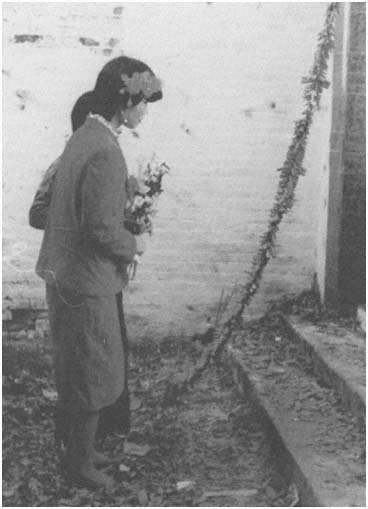
Small-town bride about to enter her husband's home (Helen Siu)
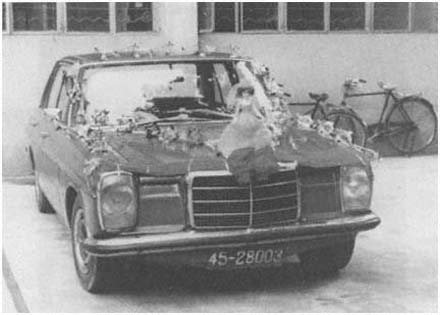
Bridal car to carry her to banquet (Helen Siu)
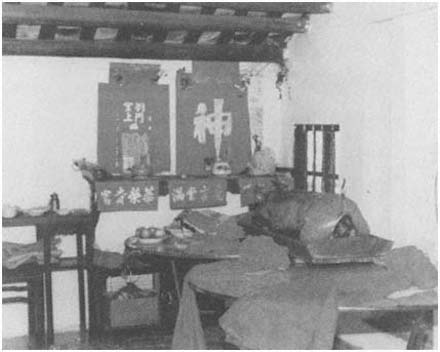
Presentations before the family altar (Helen Siu)
The Making of a Stem Family
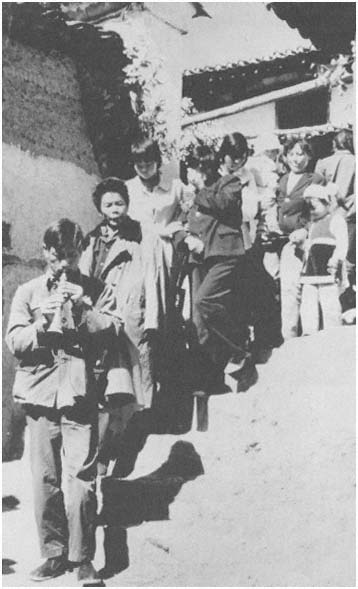
A weeping bride is led away from her parents' home. (Stevan Harrell)
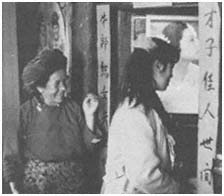
A proud mother-in-law ushers her new daughter-
in-law into the bridal chamber. (Stevan Harrell)
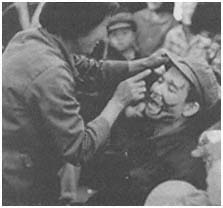
A relative of the bride paints the groom's parents' faces to ensure
their good humor toward their daughter-in-law. (Stevan Harrell)
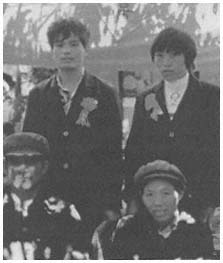
A new stem family poses for a formal portrait. (Stevan Harrell)
Family Portraits
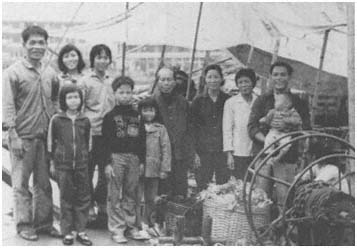
Small-town fishing family (Helen Siu)
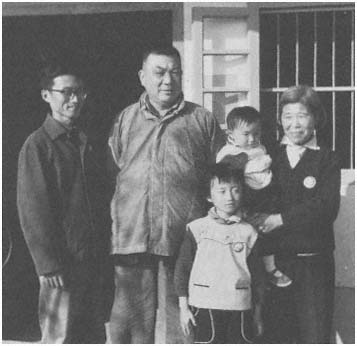
Multigenerational family in Shanghai (Graham E. Johnson)
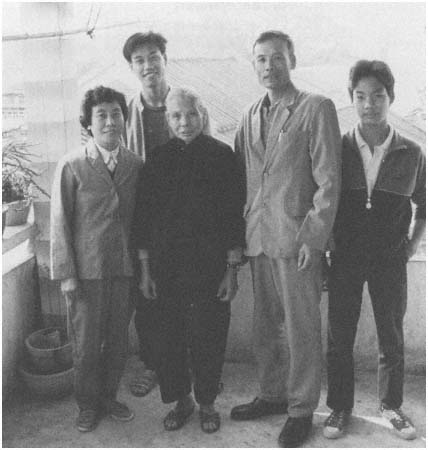
Multigenerational family in rural Guangdong (Graham E. Johnson)
Entrepreneurs
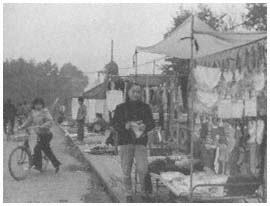
Chengdu stallkeeper (Hill Gates)
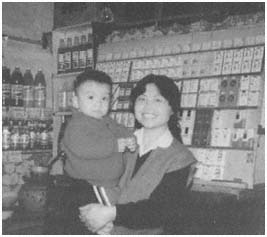
Chengdu Shopkeeper (Hill Gates)

The proud owner of a new house with modern
furniture, Renhe, Panzhihua (Stevan Harrell)
Housing Styles
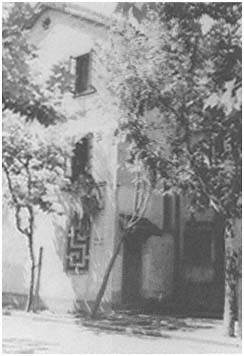
Shanghai apartment building,
constructed in the 1950s (Deborah Davis)
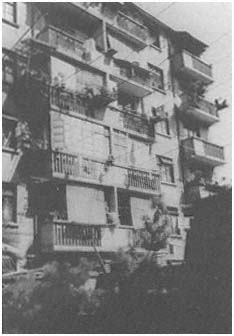
Shanghai apartment building,
constructed in 1978 (Deborah Davis)

Shanghai apartment building, constructed in 1988 (Deborah Davis)
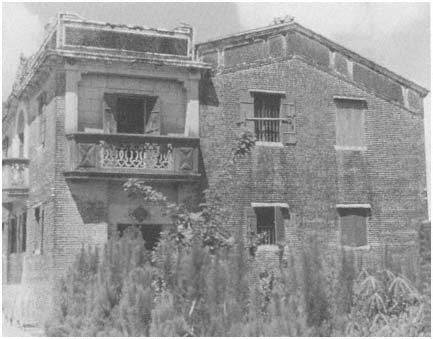
Village house built with Canadian remittances, Duanfen, Taishan, Guangdong (Graham e. Johnson)
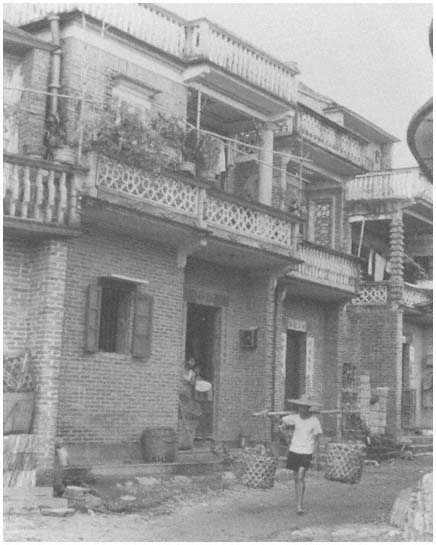
New house with traditional ritual couplets, Fucheng, Dongguan, Guangdong (Graham E. Johnson)
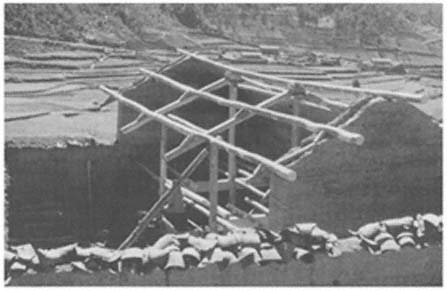
Old-style mud-walled housing under construction in Yishala, Panzhihua, Sichuan(Stevan Harrell)
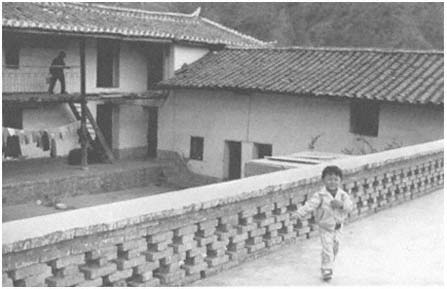
New-style mansion of twenty-nine rooms, home to a family of ten in Renhe, Panzhihua (Stevan Harrell)